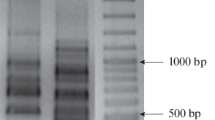Abstract
Biphenyl 2,3-dioxygenase is the key enzyme involved in the bacterial destruction of biphenyl and polychlorinated biphenyls (PCBs), which are highly stable toxic compounds. The diversity of bphA1 genes encoding the biphenyl 2,3-dioxygenase a-subunit of biphenyl-degrading bacteria from the microbial community of the Bering Sea coastal sediments (the Anadyr port area) was studied. The enrichment culture was obtained by the incubation of bottom sediments samples with biphenyl as the only carbon source. It was followed by total DNA extraction and PCR analysis with degenerate primers specific to the bacterial biphenyl 2,3-dioxygenase α-subunit genes. Subsequent cloning of the PCR products led to the identification of three types of aromatic dioxygenase genes, which appeared to be phylogenetically close to the genes of the biphenyl/toluene dioxygenase and 3-phenylpropionate dioxygenase subfamilies of the Actinomycetales bacteria.
Similar content being viewed by others
References
http://www.amap.no
http://www.unep/org
http://npa-arctic.iwlearn.org/Documents/da_full/section_4.3.4.pdf
Konoplev, A.V., Volkova, E.F., Kochetkov, A.I., et al., Monitoring of persistent organic pollutants in the ambient air as an element of implementation of the Stockholm Convention on persistent organic pollutants, Russ. J. Phys. Chem. B, 2012, vol. 6, no. 5, pp. 652–658.
Carrizo, D. and Gustafsson, Ö, Distribution and inventories of polychlorinated biphenyls in the polar mixed layer of seven pan-arctic shelf seas and the interior basins, Environ. Sci. Technol., 2011, vol. 45, no. 4, pp. 1420–1427.
Payne, R.B., Fagervold, S.K., May, H.D., and Sowers, K.R., Remediation of polychlorinated biphenyl impacted sediment by concurrent bioaugmentation with anaerobic halorespiring and aerobic degrading bacteria, Environ. Sci. Technol., 2013, vol. 47, no. 8, pp. 3807–3815.
Mosharova, I.V., Ecology of bacteria that transform polychlorinated biphenyls, and their place in the marine heterotrophic bioplankton, Cand. Sci. (Biol.) Dissertation, Moscow: Moscow State University, 2008.
Pieper, D.H., Aerobic degradation of polychlorinated biphenyls, Appl. Microbiol. Biotechnol., 2005, vol. 67, pp. 170–191.
Iwai, S., Chai, B., Sul, W.J., et al., Gene-targetedmetagenomics reveals extensive diversity of aromatic dioxygenase genes in the environment, ISME J., 2010, vol. 4, no. 2, pp. 279–285.
Gallego, S., Vila, J., Tauler, M., et al., Community structure and PAH ring-hydroxylating dioxygenase genes of a marine pyrene-degrading microbial consortium, Biodegradation, 2014, vol. 25, pp. 543–556.
Barriault, D. and Sylvestre, M., Catalytic activity of Pseudomonas putida strain G7 naphthalene 1,2-dioxygenase on biphenyl, Int. Biodeterior. Biodegrad., 1999, vol. 44, pp. 33–37.
Diaz, E., Ferrandez, A., and Garcia, J., Characterization of the hca cluster encoding the dioxygenolytic pathway for initial catabolism of 3-phenylpropionic acid in Escherichia coli K-12, J. Bacteriol., 1998, vol. 180, no. 11, pp. 2915–2923.
Ohmori, T., Morita, H., Tanaka, M., et al., Development of a strain for efficient degradation of polychlorinated biphenyls by patchwork assembly of degradation pathways, J. Biosci. Bioeng., 2011, vol. 111, no. 4, pp. 437–442.
Author information
Authors and Affiliations
Corresponding author
Additional information
Original Russian Text © E.S. Shumkova, A.O. Voronina, N.V. Kuznetsova, E.G. Plotnikova, 2015, published in Genetika, 2015, Vol. 51, No. 7, pp. 841–846.
Rights and permissions
About this article
Cite this article
Shumkova, E.S., Voronina, A.O., Kuznetsova, N.V. et al. Diversity of key biphenyl destruction genes in the microbial community of the Anadyr Bay coastal sediments. Russ J Genet 51, 720–724 (2015). https://doi.org/10.1134/S1022795415070121
Received:
Published:
Issue Date:
DOI: https://doi.org/10.1134/S1022795415070121




